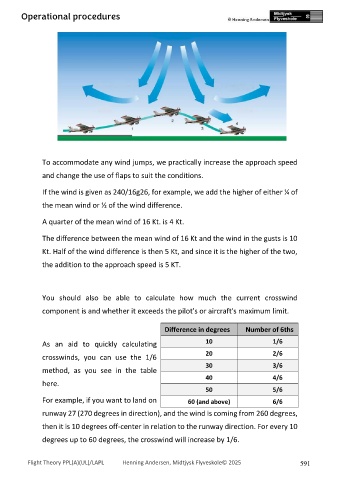Page 591 - engelsk
P. 591
Operational procedures
To accommodate any wind jumps, we practically increase the approach speed
and change the use of flaps to suit the conditions.
If the wind is given as 240/16g26, for example, we add the higher of either ¼ of
the mean wind or ½ of the wind difference.
A quarter of the mean wind of 16 Kt. is 4 Kt.
The difference between the mean wind of 16 Kt and the wind in the gusts is 10
Kt. Half of the wind difference is then 5 Kt, and since it is the higher of the two,
the addition to the approach speed is 5 KT.
You should also be able to calculate how much the current crosswind
component is and whether it exceeds the pilot's or aircraft's maximum limit.
Difference in degrees Number of 6ths
As an aid to quickly calculating 10 1/6
20 2/6
crosswinds, you can use the 1/6
30 3/6
method, as you see in the table
40 4/6
here.
50 5/6
For example, if you want to land on 60 (and above) 6/6
runway 27 (270 degrees in direction), and the wind is coming from 260 degrees,
then it is 10 degrees off-center in relation to the runway direction. For every 10
degrees up to 60 degrees, the crosswind will increase by 1/6.
Flight Theory PPL(A)(UL)/LAPL Henning Andersen, Midtjysk Flyveskole© 2025 591

